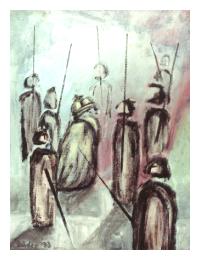Pawn Endgame
Home * Evaluation * Game Phases * Endgame * Pawn Endgame

The Pawn Endgame is an endgame actually without any pieces but only pawns and kings. Pawn endings somehow remind on a completely different game domain, requiring special evaluation routines, as well as conditions inside the search, i. e. switching of null move pruning. Specially in "closed" or blocked pawn endgames with rammed and backward pawns with only very few reasonable moves due to extremely low mobility, zugzwang, stalemate, triangulation, tempo issues, the concepts of opposition or more general corresponding squares, and king path puzzles start to dominate. Otherwise, in open pawn endings, naturally with a bigger branching factor than the closed, all kinds of passed pawn issues are taken into account.
Using the transposition table is essential in pawn endings, as demonstrated in positions like the Lasker-Reichhelm Position (Fine 70) or the Réti Endgame Study with astonishing search depths. Certainly, many programs extend a lot, if the last piece was captured with the transition into an "unclear" pawn endgame. Ed Schröder for instance, extends by three plies in Rebel considering bounds [2] .
Contents
Considerations
- Backward Pawn
- Blockage Detection
- Candidate Passed Pawn
- Capture Extensions
- Connected Passed Pawns
- Corresponding Squares
- Hidden Passed Pawn
- King Pawn Tropism
- KPK database/rules
- Opposition
- Outside Passed Pawn
- Pawns Breakthrough
- Pawn Race
- Passed Pawn
- Passed Pawn Extensions
- Protected Passed Pawn
- Rule of the Square
- Stalemate
- Tempo
- Triangulation
- Zugzwang
Pawn Endgame Programs
Pawn Endgame Positions
- Lasker-Reichhelm Position (Fine 70)
- Réti Endgame Study
See also
- King and Pawns from King Pattern in Bitboards
- Null Move Pruning
- Pawn Hash Table
- Pawn Pattern and Properties in Bitboards
- Pawn Structure
- Queen versus Pawn
- Transposition Table
Publications
Chess
- Vitali Halberstadt and Marcel Duchamp (1932). L'opposition et les cases conjuguées sont réconciliées. » Corresponding Squares
- Paris-Brussels 1932, German Edition 2001 Opposition und Schwesterfelder, ISBN 3-932170-35-0
- Reuben Fine (1941). Basic Chess Endings, Chapter 2, King and Pawn Endings
- Yuri Averbakh, Ilia Maizelis (1987). Comprehensive Chess Endings Vol 4: Pawn Endings, Cadogan Books 1987.
- Karsten Müller, Frank Lamprecht (2000). Secrets of Pawn Endings. Everyman Chess, (2007). re-issue by Gambit Publications
- Eric Schiller (2006). Of Kings and Pawns - Chess Strategy in the Endgame, Universal Publishers, ISBN-13: 978-1581129090, amazon, sample chapter as pdf
Computer Chess
1977 ...
- Monroe Newborn (1977). PEASANT: An endgame program for kings and pawns. Chess Skill in Man and Machine » Peasant
- Crispin Perdue, Hans Berliner (1977). EG: a case study in problem solving with king and pawn endings. 5. IJCAI 1977
- Kenneth W. Church (1978). Co-ordinate Squares: A Solution to Many Chess Pawn Endgames. B.Sc. thesis, Massachusetts Institute of Technology, reprinted 1988 in Computer Chess Compendium
- Kenneth W. Church (1979). Co-ordinate Squares: A Solution to Many Chess Pawn Endgames. (abbreviated version of B.Sc. thesis), IJCAI-79, Tokyo, Japan
- Peter W. Frey, Larry Atkin (1979). Creating a Chess-Player, Part 4: Thoughts on Strategy. In Blaise W. Liffick (ed.), The Byte Book of Pascal, pp. 143-155. Byte Publications, also BYTE, Vol. 4, No. 1 » Corresponding Squares
1980 ...
- Helmut Horacek (1982). Ein Modell für Schachbauernendspiele mit menschlichen Problemlösungstechniken. PhD-Thesis, Department of Computer Science, University of Vienna, Supervisors: Prof. Dr. Curt Christian (University of Vienna) and Prof. Dr. Wilhelm Barth (Vienna University of Technology).
- Helmut Horacek (1982). Construction of Planned Move Trees for Chess Pawn Endings. Sigart Newsletter 80, pp. 163-168.
- Helmut Horacek (1983). Knowledge-Based Move Selection and Evaluation to Guide the Search in Chess Pawn Endings. ICCA Journal, Vol. 6, No. 3
- Murray Campbell, Hans Berliner (1983). A Chess Program That Chunks. AAAI 1983 49-53, pdf » Chunker
- Hans Berliner, Murray Campbell (1984). Using Chunking to Solve Chess Pawn Endgames. Artificial Intelligence, Vol. 23, No. 1, pp. 97-120. ISSN 0004-3702
- Andrew N. Walker (1989). Interactive Solution of King and Pawn Endings. Advances in Computer Chess 5
1990 ...
- Wilhelm Barth (1995). Combining Knowledge and Search to Yield Infallible Endgame Programs A study of passed Pawns in the KPKP endgame. ICCA Journal, Vol. 18, No. 3 [3]
- Wilhelm Barth (1995). The KPKP Endgame: An Amplification. ICCA Journal, Vol. 18, No. 4
2000 ...
- Omid David, Ariel Felner, Nathan S. Netanyahu (2004). Blockage Detection in Pawn Endgames. ICGA Journal, Vol. 27, No. 3
- Zvi Retchkiman Königsberg (2007). A Combinatorial Game Mathematical Strategy Planning Procedure for a Class of Chess Endgames. International Mathematical Forum, Vol. 2, No. 68
2010 ...
- Monroe Newborn, Robert Hyatt (2014). Computer Chess Endgame Play with Pawns: Then and Now. ICGA Journal, Vol. 37, No. 4 » Peasant, Crafty
Forum Posts
1997 ...
- Deep analyses of pawn endgames by Dap Hartmann, rgcc, February 10, 1997
2000 ...
- Pawn endings [blocked pawns] by José Antônio Fabiano Mendes, CCC, January 26, 2000
- Pawn endgame test suite by Peter McKenzie, CCC, October 07, 2000 » Test-Positions
- king and pawns ending by Frank Phillips, CCC, August 23, 2002
- Is this rule safe (how has K&Ps vs K&Ps databases? ...) by Mark Lefler, CCC, June 20, 2007 » KPK, Now
- king pawn endgames by Mike Adams, CCC, January 30, 2008
2010 ...
- Pawns ending by Andres Valverde, CCC, December 10, 2010
- Code of Chiron for Detection of Pawn Blockages by Ubaldo Andrea Farina, CCC, October 13, 2011
- pawn endgame by Marek Kwiatkowski, CCC, November 28, 2012
External Links
References
- ↑ Chess Paintings by Elke Rehder
- ↑ Quote by Ed Schröder from his Programmer Corner: The Search is extended with 3 plies when the search transits to a pawn-ending. An extra window check of 3 pawns is done on I_SCORE before the extension is rewarded
- ↑ Steven Edwards (1995). Comments on Barth’s Article “Combining Knowledge and Search to Yield Infallible Endgame Programs.” ICCA Journal, Vol. 18, No. 4